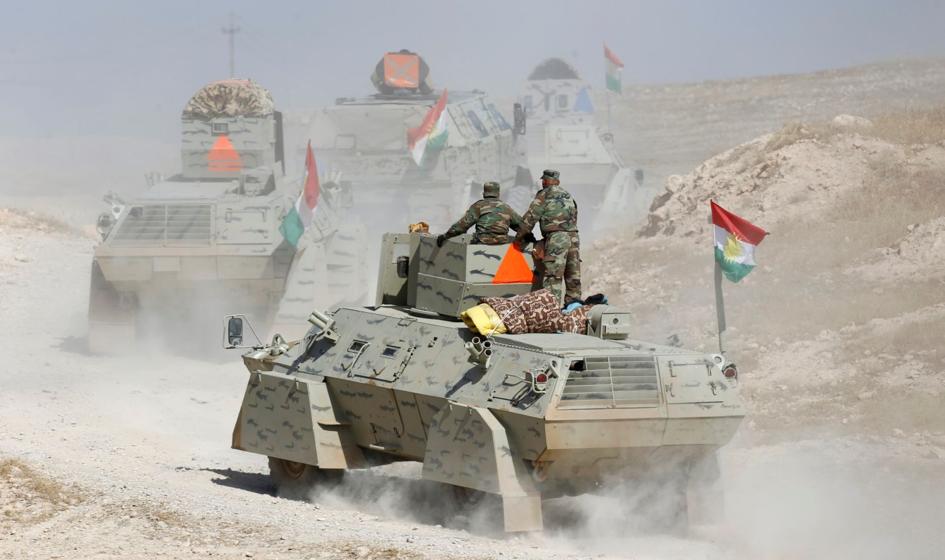The Naval Missile Brigade of the Polish Navy will be built on the Polish coast. This is the next stage of strengthening the coastal squadrons, an important element in NATO’s deterrence policy. It is also a sign that the role of the Baltic Sea in geopolitical calculations has increased significantly.

A column of vehicles leaves the Siemirowice base in Pomerania, with missile launchers, command, and armored recovery vehicles, and a mobile communication node. If the enemy ships launch an attack on the southern Baltic Sea, they will be hit by a powerful blow of deadly missiles. The same will happen when airborne troops make an attempt to land on the Polish coast. This is how the Naval Missile Unit (NMU) works.
In recent years, it has manifested its potential many times – both in the country and abroad. It was effective enough to leave the decision-makers without doubts, and they decided to strengthen this potential.
Missile Addition
“The Navy Missile Brigade will be formed by the sea,” Władysław Kosiniak-Kamysz, Polish Deputy Prime Minister and Minister of Defense, announced at the beginning of March. It will be the fourth tactical group designed for operations within the Baltic Sea – along with the 3rd Ship Flotilla, the 8th Coastal Defense Flotilla, and the Polish Navy Air Brigade. The decision is a natural consequence of the contracts concluded by Poland for the expansion of coastal strike systems. In the autumn of 2023, the Ministry of Defense signed contracts to supply equipment for two more NMUs. The order is to be completed by the Norwegian Kongsberg, supported by two Polish companies – PIT-Radwar and Wojskowe Zakłady Elektroniczne. The value of the transaction is 8 billion Polish zlotys, and deliveries should begin in 2026. The units are to be equipped with NSM Block 1A (Naval Strike Missile) missiles, i.e. missiles of a newer generation than those used in the first NMU. Their range is not 200 km, but even about 300 km.
For now, little is known about the new brigade. Although the relevant documents have been signed, work on its formation is still ongoing. Without much risk, it can be assumed that part of the forces will be stationed, as they have been so far, in Siemirowice. The second of the three units may be deployed in Zegrze Pomorskie near Koszalin. At least this resulted from the response to the parliamentary interpellation given at the end of August 2024 by the Secretary of State, Paweł Bejda.

Meanwhile, experts have no doubt that the formation of the brigade proves that the significance of the Baltic Sea in geopolitical calculations has seriously increased. The sea routes are the main supply routes to Poland, the Baltic states, and new NATO members – the Scandinavians, and the sea bottom is braided with oil-pumping pipelines and telecommunications cables. In addition, Russia is just behind the fence. For that reason, the new tactical group focused on the Baltic Sea is to bring tangible benefits to Poland.
“Subsequent coastal squadrons will allow to seal the gap that was created at the beginning of the century when small missile ships of Osa and Tarantul class were withdrawn from service,” says Cpt (N) Artur Kołaczyński, Chief of Staff at the Maritime Operations Center – Maritime Component Command, who commanded the NMU in Siemirowice for several years. Although, as he claims, coastal missile launchers should not be treated as an alternative to vessels. “After all, these have much more complex tasks – especially during peace or crisis times. The NMU will not deter the submarine, will not go on patrol, will not monitor critical infrastructure,” the officer says. “That’s why, I consider the missile brigade as a complement to the naval forces. But not their equivalent,” he adds.
Prof. Andrzej Makowski from the Naval Academy (AMW), a specialist in naval force strategy, speaks in a similar tone. “The expansion of the coastal missile forces will significantly affect the expansion of the so-called ‘no-go bubble.’ It will allow for exercising control not only over Polish territorial waters but also over shipping routes within practically the entire southern Baltic Sea,” the expert notes. “We will get another batch of good and proven Kongsberg anti-ship missiles, which are used in various navies located around the world – from Australia to the United States. Their range is large enough for a missile fired from the vicinity of Ustka to land even somewhere in the middle of Sweden’s Skania,” he emphasizes. But again – such capabilities will be useful during an armed conflict. “Firing a missile in a situation where the enemy, as it is happening now, reaches for hybrid fighting tools, such as disrupting telecommunications cables at the sea bottom or trying to paralyze the shipping of civilian vessels, would be tantamount to the outbreak of open war. Here you have to act differently, sending ships to sensitive waters. This does not mean, of course, that the NMU in peacetime is useless. It is an ideal tool for NATO’s deterrence strategy,” emphasizes Prof. Andrzej Makowski. In other words, the mere presence of such a powerful weapon will help keep the opponent in check.
Projection in Iceland
The history of coastal missile subunits dates back to the 1960s. At that time, the Polish Navy owned the B-163 towed launchers, which, however, turned out to be impractical. Their size and weight made it hard to redeploy them to designated regions. For that reason, they were soon got rid of. The new equipment was for some time considered, but the idea was eventually abandoned for a longer period, until the 21st century, when Poland was already a NATO member. In 2011, the Coastal Missile Squadron was established in Siemirowice, and became part of the 3rd Ship Flotilla. Soon, a second squadron joined in, and it was on its basis that the Naval Missile Unit was formed exactly a decade ago.
The core of the NMU consists of mobile launchers mounted on the Jelcz chassis. They can move on asphalt roads, dirt roads, and forest ducts. Each is equipped with four NSMs with a 200-km range. Missiles never fly in a straight line. Before they reach their destination, they maneuver in such a way as to make life difficult for the enemy’s anti-aircraft defense.
In addition to launchers, the NMUs also have a radar station that monitors the airspace situation within a radius of 240 km and at sea at a distance of up to 50 km. Its service team can participate in engaging targets. However, data about targets mostly come from other sources – for example, ships or aircraft operating on the Baltic Sea. The data is collected by a mobile communication node. Then, the data is transferred to the command vehicles at the higher command levels, where the decision to strike is worked on. The unit is complemented by logistics vehicles for transporting missiles, and finally anti-aircraft units with artillery and missile systems. Their task, in turn, is to cover the entire column.

Individual NMU squadrons consist of battery combat modules that can successfully operate independently. There are numerous examples of such use in recent years, not only on the Polish coast. “Thanks to its mobility, the NMU can operate far beyond the country’s borders. In 2023, our components operated simultaneously in Sweden, Estonia, and Poland,” recalls Cpt (N) Bogdan Tomaszycki, Commander of the Naval Missile Unit. The occasion was a series of exercises that demonstrated NATO’s ability to defend the eastern flank.
NSM launchers and assisting vehicles went abroad on board the Lublin-class transport and mine ships. They were located in Gotland, at the junction of the Gulf of Finland and the open sea, and on the central and eastern coast of Poland. Thus, they stretched the missile umbrella over the key routes for Baltic shipping. “We have shown that we are an important element of the collective security strategy. We can interact with allies in many sensitive areas, bringing significant value to NATO forces,” emphasizes Cpt (N) Bogdan Tomaszycki.
This applies not only to the Baltic Sea. In 2024, for example, NMU combat modules performed similar tasks during Exercise Sea Shield 2024 in Romania and Exercise Northern Viking 2024 in Iceland. In each case, Polish mariners reached the combat zone by air. They took advantage of the opportunities offered by the An-124 Ruslan transport aircraft and NATO’s SALIS (Strategic Airlift Interim Solution) strategic transport program. “Each such exercise is not only an opportunity to gain invaluable experience. In this way, we also build trust among our allies in the Polish army,” the commander of the NMU convinces.
Ships Still Count
Meanwhile, not only is Poland expanding its coastal missile forces but also, back in 2016, Sweden began to recreate such abilities. The culmination of this process took place barely two months ago. At that time, the Swedish Navy officially announced the establishment of the 32nd Coastal Missile Squadron. The unit with Saab’s RBS 15Mk II guided anti-ship missiles is stationed in Karlskrona.
Estonia went in a similar direction. In the fall of 2021, the authorities in Tallinn announced that they were going to acquire Blue Spear missiles from the Singaporean-Israeli Proteus Advance consortium, the range of which is almost 300 km. The missiles were delivered a year ago. They will be fired from launchers mounted on Scania trucks. The Coastal Defense Squadron is responsible for operating the new system.
At the end of 2023, Latvia signed a contract for the NSMs acquisition. For Latvia, as well as for Estonians, such a solution is a new one. Finland, on the other hand, has long had coastal missile systems. It uses the 85M MTO missile launchers, which are mounted onto trucks and have a 100-km range. Interestingly, the local coast is also supposed to be defended by... barrel artillery. For now, the Finns use stationary cannons. Last year, however, they began the process of acquiring mobile systems.

However, the boom for sea missile vessels applies not only to countries located on the Baltic Sea. Romania, which ordered NSMs some time ago, is also increasing its capabilities. They are supposed to replace the outdated Rubież system, remembering the Soviet times. Finally, the US Marines use mobile launchers to combat targets at sea. At their disposal, they have NSMs, as well as Raytheon Tomahawk Block V long-range missiles.
Therefore, Polish activities are perfectly in line with the global trend. “This is a good direction,” says Cpt (N) Artur Kołaczyński. “The launchers can be acquired faster than the ships, they are also cheaper and easier to maintain. In the event of an armed conflict, they significantly increase the firepower available to the Polish Navy,” he adds. Therefore, it can be expected that interest in such solutions will not weaken any time in the near future. Especially among the countries of the NATO eastern flank, which must arm themselves not only intensively, but also quickly. However, this does not mean traditional proportions will be shaken in the maritime area. The ships will remain at the core of the navies, even if they operate on waters as small as the Baltic Sea, which is reflected in the orders placed by individual countries. It is not only Poland that wants to acquire new vessels. Finland, Sweden, and Germany are following the same path.
_______________
Translated by Anita Kwaterowska






